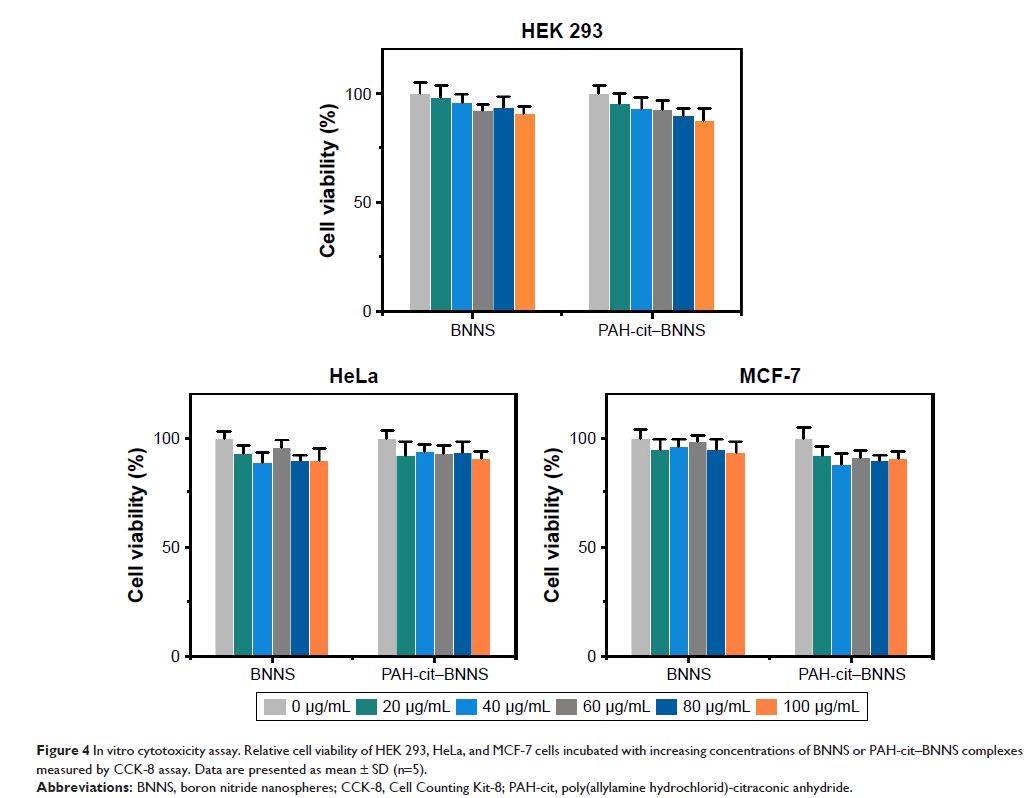108985
论文已发表
注册即可获取德孚的最新动态
IF 收录期刊
- 3.4 Breast Cancer (Dove Med Press)
- 3.2 Clin Epidemiol
- 2.6 Cancer Manag Res
- 2.9 Infect Drug Resist
- 3.7 Clin Interv Aging
- 5.1 Drug Des Dev Ther
- 3.1 Int J Chronic Obstr
- 6.6 Int J Nanomed
- 2.6 Int J Women's Health
- 2.9 Neuropsych Dis Treat
- 2.8 OncoTargets Ther
- 2.0 Patient Prefer Adher
- 2.2 Ther Clin Risk Manag
- 2.5 J Pain Res
- 3.0 Diabet Metab Synd Ob
- 3.2 Psychol Res Behav Ma
- 3.4 Nat Sci Sleep
- 1.8 Pharmgenomics Pers Med
- 2.0 Risk Manag Healthc Policy
- 4.1 J Inflamm Res
- 2.0 Int J Gen Med
- 3.4 J Hepatocell Carcinoma
- 3.0 J Asthma Allergy
- 2.2 Clin Cosmet Investig Dermatol
- 2.4 J Multidiscip Healthc

用于细胞内多柔比星递送的 pH 响应性电荷反转的聚合物官能化氮化硼纳米球
Authors Feng SN, Zhang HJ, Zhi CY, Gao XD, Nakanishi H
Received 7 October 2017
Accepted for publication 7 December 2017
Published 31 January 2018 Volume 2018:13 Pages 641—652
DOI https://doi.org/10.2147/IJN.S153476
Checked for plagiarism Yes
Review by Single-blind
Peer reviewers approved by Dr Govarthanan Muthusamy
Peer reviewer comments 3
Editor who approved publication: Dr Linlin Sun
Background: Anticancer drug-delivery systems (DDSs) capable of responding to the
physiological stimuli and efficiently releasing drugs inside tumor cells are
highly desirable for effective cancer therapy. Herein, pH-responsive,
charge-reversal poly(allylamine hydrochlorid)-citraconic anhydride (PAH-cit)
functionalized boron nitride nanospheres (BNNS) were fabricated and used as a
carrier for the delivery and controlled release of doxorubicin (DOX) into
cancer cells.
Methods: BNNS was synthesized through a chemical vapor
deposition method and then functionalized with synthesized charge-reversal
PAH-cit polymer. DOX@PAH-cit–BNNS complexes were prepared via step-by-step
electrostatic interactions and were fully characterized. The cellular uptake of
DOX@PAH-cit–BNNS complexes and DOX release inside cancer cells were visualized
by confocal laser scanning microscopy. The in vitro anticancer activity of
DOX@PAH-cit–BNNS was examined using CCK-8 and live/dead viability/cytotoxicity
assay.
Results: The PAH-cit–BNNS complexes were nontoxic to
normal and cancer cells up to a concentration of 100 µg/mL. DOX was loaded on
PAH-cit–BNNS complexes with high efficiency. In a neutral environment, the
DOX@PAH-cit–BNNS was stable, whereas the loaded DOX was effectively released
from these complexes at low pH condition due to amide hydrolysis of PAH-cit.
Enhanced cellular uptake of DOX@PAH-cit–BNNS complexes and DOX release in the
nucleus of cancer cells were revealed by confocal microscopy. Additionally, the
effective delivery and release of DOX into the nucleus of cancer cells led to
high therapeutic efficiency.
Conclusion: Our findings indicated that the newly developed
PAH-cit–BNNS complexes are promising as an efficient pH-responsive DDS for
cancer therapy.
Keywords: boron nitride
nanospheres, drug delivery, doxorubicin, pH-responsive charge-reversal,
controlled release
